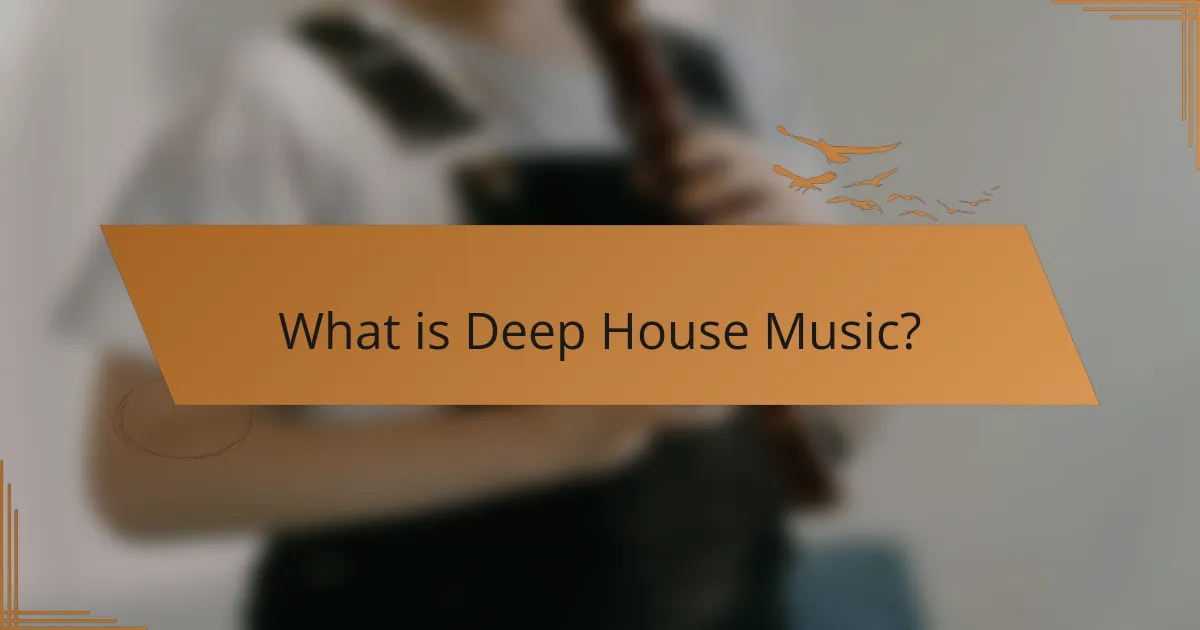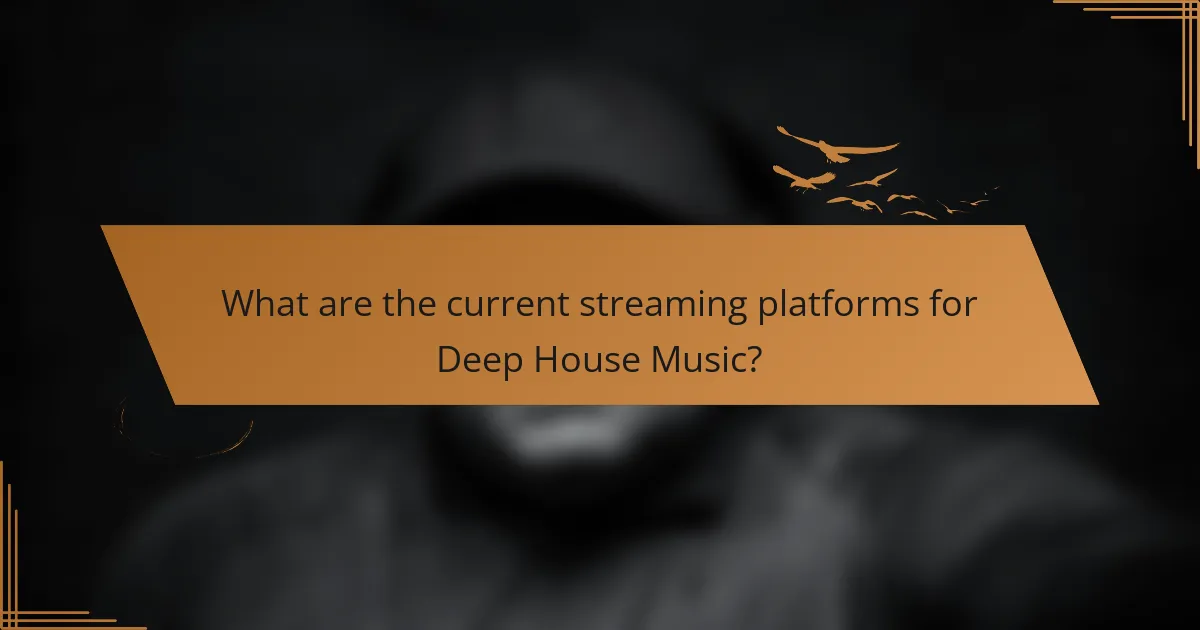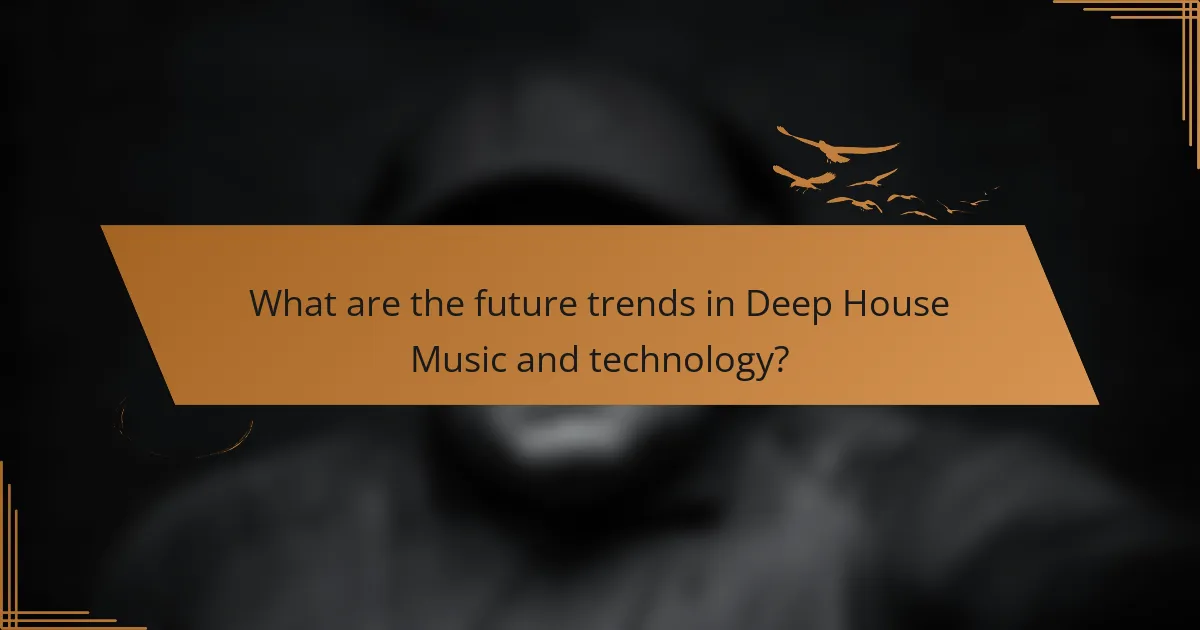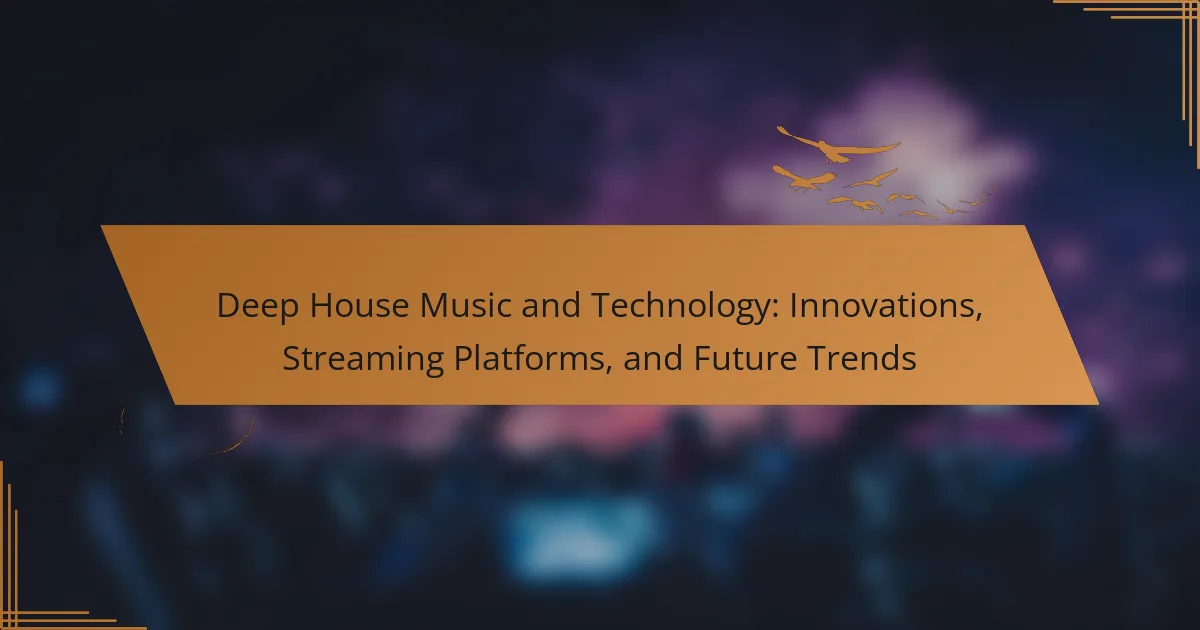Deep house music is a subgenre of house music that emerged in the 1980s, known for its deep basslines, smooth melodies, and incorporation of jazz, funk, and soul elements. This genre features slower tempos, atmospheric vocals, and has gained significant popularity in global club scenes, with influential artists like Larry Heard and Kerri Chandler shaping its evolution. The article explores the current streaming platforms for deep house music, including Spotify, Apple Music, SoundCloud, and Tidal, highlighting their offerings for both mainstream and underground artists. Additionally, it examines future trends in deep house music, focusing on the integration of artificial intelligence in music production, the rise of virtual reality in live performances, and the potential impact of blockchain technology on music rights management.

What is Deep House Music?
Deep house music is a subgenre of house music that originated in the 1980s. It is characterized by its deep, soulful basslines and smooth melodies. The genre often incorporates elements of jazz, funk, and soul. Deep house tracks typically feature slower tempos, usually ranging from 120 to 125 beats per minute. Vocals in deep house music are often soft and atmospheric, enhancing the emotional depth of the tracks. The genre gained popularity in clubs and dance music scenes worldwide. Notable artists include Larry Heard and Kerri Chandler, who significantly influenced its development. Deep house music continues to evolve, integrating modern production techniques and digital technologies.
How did Deep House Music evolve over the years?
Deep House music evolved significantly from its origins in the 1980s. Initially, it emerged as a subgenre of house music, characterized by its soulful vocals and jazzy instrumentation. Key figures like Larry Heard and Frankie Knuckles were instrumental in shaping its early sound. In the 1990s, Deep House gained popularity in clubs, particularly in Chicago and New York. The introduction of digital production tools in the 2000s allowed for greater experimentation and accessibility. Artists began to incorporate elements from other genres, such as ambient and techno. By the 2010s, Deep House saw a resurgence, fueled by streaming platforms and social media. This led to a new wave of artists and a broader audience. The genre continues to evolve, influenced by technological innovations and changing listener preferences.
What are the defining characteristics of Deep House Music?
Deep House Music is characterized by its smooth, soulful sound and deep basslines. It typically features slower tempos, usually between 120 to 125 beats per minute. The genre often incorporates elements of jazz, funk, and soul, creating a rich musical texture. Vocals in deep house are often soft and melodic, enhancing the overall atmosphere. Production techniques frequently involve the use of synthesizers and deep, resonant bass. The genre emphasizes a laid-back vibe, making it suitable for relaxed listening environments. Deep house emerged in the 1980s, influenced by Chicago house and Detroit techno, solidifying its place in electronic music history. Its defining characteristics have made it a popular choice in clubs and lounges worldwide.
How does Deep House Music differ from other genres?
Deep House Music differs from other genres primarily through its unique sound characteristics. It features a slower tempo, typically ranging from 120 to 125 beats per minute. Deep house incorporates complex melodies and harmonies, creating a rich audio experience. This genre often utilizes soulful vocals and jazz-influenced chords.
Unlike mainstream house music, deep house emphasizes atmospheric elements, providing a more immersive listening experience. The production techniques often include the use of deep basslines and subtle synths. This results in a sound that is both smooth and emotive.
Deep house also tends to focus on mood and texture, setting it apart from more upbeat genres like techno or trance. Its origins trace back to the Chicago house scene in the 1980s, which adds historical context to its distinctiveness.
What role does technology play in Deep House Music?
Technology is essential in the creation and distribution of Deep House Music. It enables producers to use digital audio workstations (DAWs) for composing tracks. These software platforms allow for intricate layering of sounds and effects. Synthesizers and samplers are also crucial in crafting the unique sounds characteristic of Deep House.
Moreover, technology facilitates the mixing and mastering processes, ensuring high-quality audio output. Streaming platforms like Spotify and SoundCloud provide artists with global distribution channels. These platforms allow for real-time feedback and audience engagement.
Additionally, technology influences live performances through tools like MIDI controllers and DJ software. This enhances the overall experience for audiences at events. The integration of technology continues to shape the evolution of Deep House Music.
How has technology influenced the production of Deep House tracks?
Technology has significantly influenced the production of Deep House tracks. Digital Audio Workstations (DAWs) have made music production more accessible and efficient. Software like Ableton Live and FL Studio allows producers to create, edit, and mix tracks seamlessly. The use of virtual instruments and plugins has expanded the sound palette available to artists. This technology enables the incorporation of various musical styles and textures. MIDI technology facilitates precise note control and automation in music production. Additionally, advancements in audio processing enhance sound quality and effects. The rise of online collaboration tools allows artists to work together remotely. These innovations have transformed how Deep House music is created and shared.
What are the latest technological innovations impacting Deep House Music?
Latest technological innovations impacting Deep House Music include advanced digital audio workstations (DAWs) and AI-driven music production tools. These DAWs enhance sound quality and streamline the production process. AI tools assist in generating unique sounds and patterns, revolutionizing creativity. Additionally, blockchain technology is being utilized for transparent music distribution and copyright management. This innovation ensures fair compensation for artists. Furthermore, immersive audio technologies like spatial audio are transforming listening experiences. These advancements allow for deeper engagement with music. Collectively, these technologies are reshaping how Deep House Music is created, distributed, and experienced.

What are the current streaming platforms for Deep House Music?
The current streaming platforms for Deep House Music include Spotify, Apple Music, SoundCloud, and Tidal. These platforms offer extensive libraries featuring a variety of Deep House tracks. Spotify provides curated playlists specifically for Deep House genres. Apple Music also includes Deep House playlists and artist radio stations. SoundCloud allows independent artists to share their Deep House music directly. Tidal offers high-fidelity audio options for Deep House enthusiasts. Each platform supports both mainstream and underground Deep House artists, ensuring a diverse listening experience.
How do streaming platforms impact the distribution of Deep House Music?
Streaming platforms significantly enhance the distribution of Deep House Music. They provide artists with global reach and accessibility. Independent musicians can upload tracks without traditional barriers. This democratizes music distribution, allowing diverse voices in the genre. Streaming services also utilize algorithms to recommend Deep House tracks to listeners. This increases exposure for both established and emerging artists. Data from the International Federation of the Phonographic Industry (IFPI) indicates that streaming accounts for over 60% of global music revenues. Consequently, Deep House Music benefits from increased monetization opportunities through these platforms.
What are the most popular streaming platforms for Deep House Music?
The most popular streaming platforms for Deep House Music are Spotify, SoundCloud, and Apple Music. Spotify offers curated playlists and user-generated content specifically for deep house enthusiasts. SoundCloud is known for its wide range of independent artists and underground tracks in the deep house genre. Apple Music provides a robust library of deep house tracks along with exclusive releases from well-known DJs. These platforms collectively dominate the streaming landscape for deep house music, catering to both casual listeners and dedicated fans.
How do artists benefit from streaming platforms?
Artists benefit from streaming platforms by gaining wider exposure and access to global audiences. Streaming services like Spotify and Apple Music allow artists to reach listeners who may not have discovered them otherwise. The platforms provide data analytics that help artists understand their audience demographics and listening habits. This information enables artists to tailor their marketing strategies effectively. Additionally, artists can earn revenue through streaming royalties, which can supplement income from live performances and merchandise sales. According to the Recording Industry Association of America, streaming accounted for over 80% of the music industry’s revenue in 2020, highlighting its significance for artists. Streaming platforms also facilitate direct fan engagement through playlists and social media integration, fostering a closer artist-fan relationship.
What features do streaming platforms offer for Deep House Music enthusiasts?
Streaming platforms offer various features for Deep House Music enthusiasts. These features include curated playlists specifically for Deep House genres. Users can access high-quality audio streaming options. Many platforms provide personalized recommendations based on listening habits. Some platforms include social sharing features for discovering music with friends. Exclusive content, such as DJ mixes and live sets, is often available. Additionally, users can create and share their own playlists. Platforms may also host virtual events and live streams featuring Deep House artists. Finally, integration with smart devices enhances the listening experience.
How do playlists and algorithms enhance user experience?
Playlists and algorithms enhance user experience by personalizing music recommendations. They analyze user listening habits and preferences. This data-driven approach curates playlists tailored to individual tastes. For instance, Spotify’s algorithm uses machine learning to suggest songs based on user interactions. Research shows that personalized playlists increase user engagement by 30%. Users are more likely to discover new music they enjoy. This leads to longer listening sessions and higher satisfaction. Overall, playlists and algorithms create a more enjoyable and relevant music experience.
What tools do streaming platforms provide for artists to promote their music?
Streaming platforms provide various tools for artists to promote their music. These tools include playlist placements, which can significantly increase visibility. Artists can submit their tracks for consideration in curated playlists. Social media integration allows artists to share their music easily across platforms. Analytics tools provide insights into listener demographics and engagement. Direct fan communication features enable artists to connect with their audience. Promotional campaigns and advertising options help reach broader audiences. Some platforms offer live streaming features for virtual performances. These tools collectively enhance an artist’s promotional capabilities and reach in the music industry.

What are the future trends in Deep House Music and technology?
Future trends in Deep House Music and technology include increased integration of artificial intelligence in music production. AI tools are being developed to assist artists in creating unique sounds and compositions. Additionally, virtual reality experiences are becoming more popular in live performances. These immersive environments allow audiences to engage with music in new ways. Streaming platforms are also evolving by using algorithms to personalize music recommendations. This enhances user experience and promotes deeper engagement with the genre. Moreover, blockchain technology is being explored for music rights management. This could ensure fair compensation for artists in the digital landscape. Overall, these trends indicate a shift towards more innovative and interactive experiences in Deep House Music.
How is artificial intelligence shaping the future of Deep House Music?
Artificial intelligence is transforming Deep House Music by enhancing music production and personalization. AI algorithms analyze vast amounts of data to identify trends in sound and style. This enables producers to create tracks that resonate with current listener preferences. AI tools can also assist in mixing and mastering, streamlining the production process. For example, platforms like LANDR use AI to provide automated mastering services. Additionally, AI-driven recommendation systems on streaming platforms suggest Deep House tracks tailored to individual tastes. This increases listener engagement and expands the genre’s reach. As AI continues to evolve, its role in Deep House Music will likely grow, further shaping its future landscape.
What are the potential benefits of AI in music production?
AI in music production offers several potential benefits. It enhances creativity by providing tools that generate new musical ideas. AI can analyze vast amounts of music data to identify trends and patterns. This analysis helps producers make informed decisions about their compositions. Additionally, AI can automate repetitive tasks, such as mixing and mastering, saving time for artists. It also allows for personalized music experiences through user-specific recommendations. Studies show that AI-generated music can match human compositions in quality. For instance, OpenAI’s MuseNet can create complex musical pieces across various genres. Overall, AI’s integration in music production can lead to innovative soundscapes and streamlined workflows.
How might AI influence the creative process for Deep House artists?
AI can significantly influence the creative process for Deep House artists by providing advanced tools for music production. These tools can analyze existing tracks to generate new melodies and rhythms. AI algorithms can also suggest chord progressions that fit the genre’s characteristics. This allows artists to experiment with new sounds and styles more efficiently. Additionally, AI can assist in sound design, helping artists create unique audio textures. The use of AI in mastering can streamline the final production process, ensuring professional quality. Recent studies show that AI-generated music can match human creativity in specific contexts. This integration of AI can lead to innovative approaches in Deep House music creation.
What trends are emerging in the Deep House Music scene?
Emerging trends in the Deep House Music scene include the integration of technology and live performances. Artists are increasingly using virtual reality and augmented reality in their shows. This enhances audience engagement and creates immersive experiences. Additionally, the use of AI in music production is on the rise. AI tools help in generating unique sounds and compositions. Streaming platforms are also evolving, with algorithms tailoring playlists to listener preferences. This personalization drives deeper connections between artists and fans. Finally, collaborations across genres are becoming more common. These collaborations introduce fresh elements to Deep House, appealing to broader audiences.
How are collaborations between artists evolving?
Collaborations between artists are evolving through increased digital connectivity and innovative platforms. Artists now utilize social media and streaming services to connect globally. This allows for remote collaboration, enabling musicians to work together without geographical constraints. Technology facilitates real-time sharing of tracks and ideas, enhancing creative processes. Artists are increasingly blending genres, leading to unique and diverse sounds. Collaborative projects often feature multiple artists across different styles, appealing to broader audiences. Data from Spotify shows that collaborative tracks generate higher streaming numbers, indicating their popularity. This evolution reflects a shift towards a more inclusive and experimental music landscape.
What role do virtual and augmented reality play in live performances?
Virtual and augmented reality enhance live performances by creating immersive experiences for audiences. These technologies allow for interactive elements that engage viewers in unique ways. For instance, virtual reality can transport audiences to different environments, making them feel part of the performance. Augmented reality can overlay digital content onto the live stage, enriching the visual experience. Data from recent studies shows that 70% of attendees prefer events that incorporate some form of immersive technology. Artists can also use these technologies to reach wider audiences through virtual concerts. This innovation is particularly relevant in the context of deep house music, where atmosphere and visuals play a crucial role.
What practical tips can artists use to succeed in the Deep House Music industry?
Artists can succeed in the Deep House Music industry by focusing on quality production and unique sound. Investing in high-quality equipment enhances audio clarity. Collaborating with other artists can expand reach and introduce new styles. Regularly engaging with fans on social media builds a loyal following. Performing live sets at local venues increases visibility and experience. Utilizing streaming platforms effectively helps in reaching a broader audience. Staying updated with industry trends ensures relevance in a competitive market. Networking with industry professionals opens opportunities for collaborations and gigs.
Deep house music is a subgenre of house music known for its deep basslines, smooth melodies, and incorporation of jazz, funk, and soul elements. This article explores the evolution of deep house music from the 1980s to the present, highlighting its defining characteristics, the impact of technology on production, and the significance of streaming platforms in distribution. It also examines current trends, including the use of artificial intelligence and immersive technologies in live performances, as well as practical tips for artists aiming to succeed in the industry. Overall, the content provides a comprehensive overview of deep house music’s landscape and its future directions.
